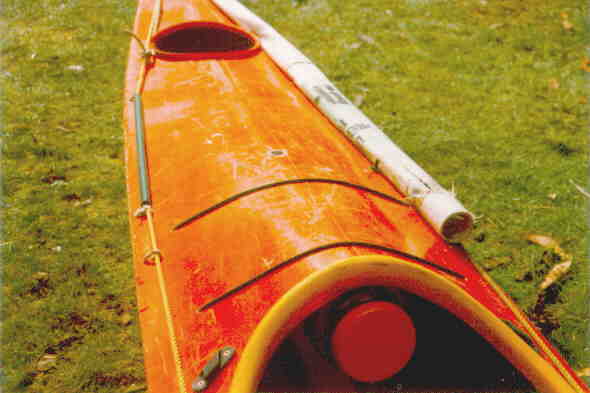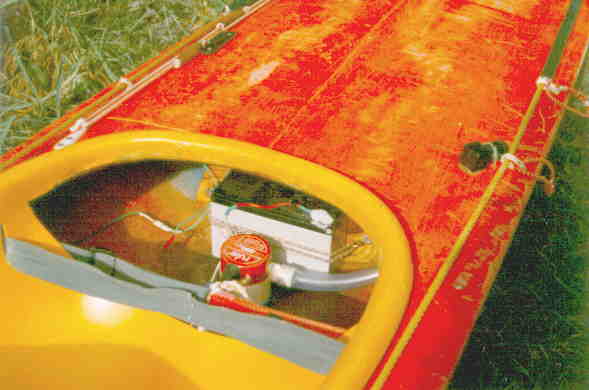Note: The year 2012. These are no longer available from Dick Smith. But this is available from Jaycar - part number ST0574

Some of my gear - Electric Pumps (From my old website) sails rudders
Back in 1979 it seemed to me that I needed some means of getting water out of a kayak, without taking my hands off my paddle. Back in those days there weren't many options of any sorts of pumps for kayaks. There was a hand pump which was fitted behind the cockpit, but which I considered fairly useless. I used to read about people demonstrating this sort of pump in a swimming pool - but that's not where I intended to do all my paddling. If conditions were so bad that I'd capsize in the first place, then I hardly thought I was going to get back in the kayak and start pumping out with one hand - I'd need both hands for supporting. I dismissed hand pumps as out of the question - despite world wide acceptance of them. There were some foot pumps about at that time - but they were only designed to remove dribbles of water that might get in through a spray deck.
Being an electronic technician of sorts, my mind turned to electric pumps - but the only thing I could find at that time was a very small submersible pump used in caravans to pump water to the sink. I used one of these for a time, with two 6v lantern batteries (dry cell) - but these corroded very easily. Switches were another problem as there were no submersible ones about. I had to buy one with a rubber 'boot', solder the wires to it, then set the bottom part of the switch in araldite (epoxy glue).
In the early 1980's the
RULE 400 pump appeared
on the scene - a lovely little submersible pump for 12v operation that
would move 400 gallons an hour. This was ideal for a kayak, and is
still
the favoured pump today (1998), although I see it has been upgraded to
500 gals/hour. Also about this time a small 'gel cell' sealed battery
appeared,
being used for backup for burglar alarms and other electronic
circuitry.
They were available in various voltages and capacities, my choice then
(and still is) was 12v, 6AH (now 7AH, though still the same size). And
lo and behold, a fully waterproof switch appeared on the market. The
only
place I have seen these in Australia is in 'Dick Smith' electronic
shops,
catalogue No. P-7664.
Note: The year
2012. These are no longer
available from Dick Smith. But this is available from Jaycar - part
number
ST0574

Click here for updated switch installation information, November 2007
 |
 |
| This shows the switch next to
the sail holder;
(and the 'glovebox'.) |
This shows the battery and
pump,
and the outlet (a 900 polypipe fitting). |
My battery is installed in the cockpit, behind the seat, against the rear bulkhead. It is held in place by a piece of shock cord. The wires to the battery are coloured differently so I know which is positve and which is negative, and both have 'spade terminals' fitted - to match the battery terminals. When I put the battery in the kayak I cover the terminals completely with small pieces of 'blue-tack', to try and keep them airtight, so they wont corrode so quickly. After each trip the battery is removed and washed in fresh water, and put away in the shed till next time. Do not charge these batteries at more than one amp - a small 12v plug pack is ideal.
November 2007:Actually I did end up leaving the battery in the kayak till the end of each paddling season - but hosed it down in fresh water after every trip
The pump can go almost anywhere, I once had it between my legs near my feet - but it is more normally behind the seat, just in front of the battery.
Maybe every 4 or 5 years you will find the wires have corroded inside their plastic insulation, and I usually pull the whole lot out and replace the switch and all the wiring. Lets face it, we are asking a lot to constantly immerse an electrical system in salt water - its worst enemy.
Never absolutely rely on your electric pump - carry a big sponge as well, just in case. I have been using electric pumps in kayaks since 1979, and wouldn't dream of putting to sea without one fitted.
(From my Bass Strait Trip report)
Slept in and missed the last of the tide, so walked the full
length
of the beach to Stackies Bight, till 2.00pm when the tide was again in
the right direction. Not that the tide would be much help, but at least
it wouldn’t be assisting the 25 - 30 knot winds that were
still whipping
up big seas from the west. Alf was a little doubtful that it was really
suitable weather for rounding Cape Frankland, but after two nights in
the
caravan I felt I would get fat and lazy if I stayed another night. A
couple
of hours later I was regretting this decision, particularly as the
forecast
for the next day had been for moderating conditions. The seas off Cape
Frankland were huge, there is no other word to describe it. I have been
out in big seas off the south-west coast before, and tried out a 50
knot
gale in Bass Strait off Low Head - but this was terrifying. The
westerly
gale was meeting a shallow bottom and a 6 knot tide, and it took all my
concentration to hang in there. At the bottom of the swells I was
looking
up a 60 degree mountain, a good 40 feet high, taking 8 to 10 paddle
strokes
to reach the top, then having the bow drop about 8 feet down the other
side before hitting the water again. Usually about half-way up the
slope
the top would topple and a wall of white water would come careering
down
to check your upward rise, often flattening you along the rear deck.
Progress
was slow, it was imperative to keep at least half a mile off shore -
any
closer and the Longboat would have been fibreglass splinters amongst
the
breakers in the shallow water. I was sort of ferry-gliding along the
shore,
rounding up into the worst breakers, then bearing away again. I would
have
dearly loved to whip out the camera to photograph the conditions, but
for
three hours was not game to even take one hand off the paddle for more
than a second, and then only to flick the pump switch on or off.
Try using a hand pump in these conditions!
Laurie Ford
NOTE:
I have only used these pumps
in V bottom kayaks, where the water runs into a deep V shape and is
easy
to pump out. There are a lot of so-called sea kayaks these days that
are
very nearly flat-bottomed. It seems to me that in these kayaks the
water
would slosh around all over the cockpit floor, and would be a lot more
trouble to get out. Turn your kayak upside down and have a good look at
it - some are so close to being flat they may as well be - like a
Nordkapp,
or most of the newer plastic kayaks I have seen around. Derek
Hutchinson's
book SEA CANOEING points out the advantage of V bottom kayaks over flat
bottom kayaks.
This page was last updated February 2012.